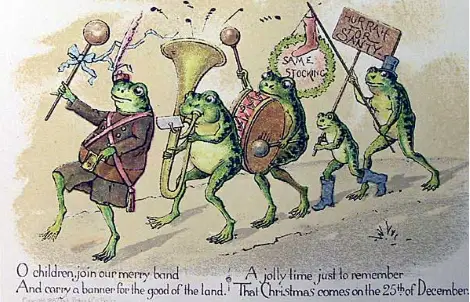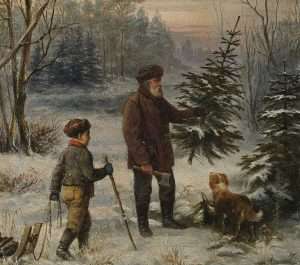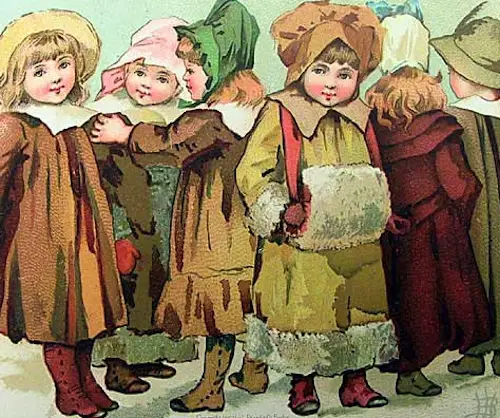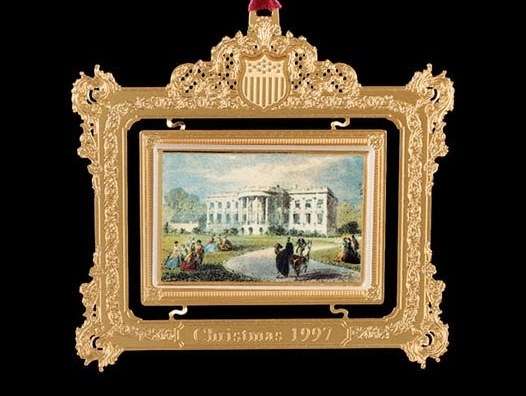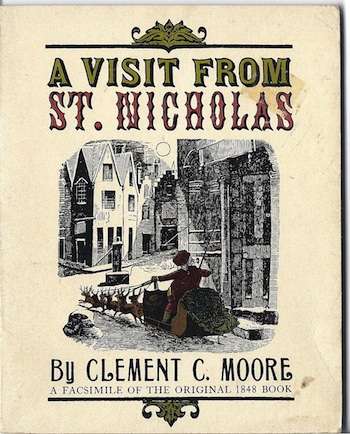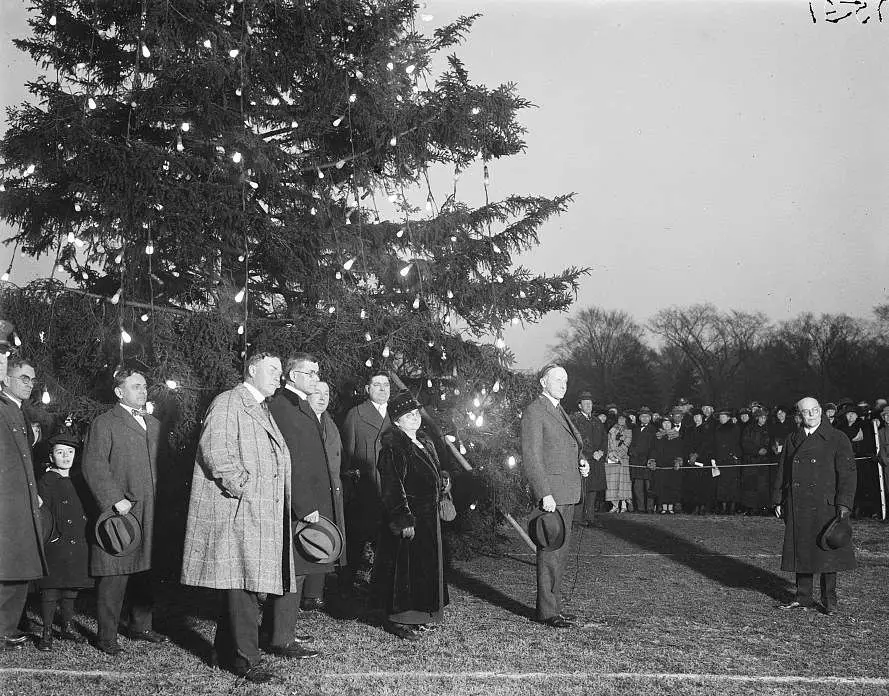New England is as unlikely a place as there is to celebrate a Christmas first. After all, Puritans in Massachusetts and Connecticut officially banned the holiday. It wasn’t until the mid-19th century that most New Englanders took the day off, let alone trimmed trees, sang carols or sent cards.
And yet, with a little imagination, we can find a Christmas first in each of the New England states.
First Christmas Tree in Connecticut
A Hessian soldier named Hendrick Roddemore put up a Christmas tree in Windsor Locks, Conn., in 1777, giving Connecticut the claim to the first Christmas tree.
The Americans captured Roddemore, a mercenary, at the Battle of Bennington.
Many prisoners from that battle were sent to Boston and then elsewhere. Roddemore ended up at the farm of Samuel Denslow in Windsor Locks. Denslow let him live in a small cabin on what is now the Noden-Reed Farm and home of the Windsor Locks Historical Society.
In 1777, Roddemore raised a Christmas tree inside that small cabin. He continued to live there until well after the war, putting up a tree every year. Today, a stone marks the spot where Roddemore put up that first tree.
First North American Christmas in Maine
Maine can claim perhaps the best Christmas first: the first Christmas, in 1604. It happened on St. Croix Island, the lost French colony of Maine.
St. Croix Island, now on the border between New Brunswick and Maine, was settled by a small band of Frenchmen headed by Sieur DeMons. Samuel Champlain served as historian and navigator. The expedition included thieves from Paris prisons and noblemen from the court of Henry IV, Catholic priests and Huguenot ministers, artisans, merchants and sailors.
The Frenchmen arrived in June, almost three years before Jamestown started. They built a fort, houses and a handmill, and they planted gardens and a field of rye.
On Christmas day, the French colonists, all men, attended services in a new chapel. They probably held two, one for the Protestants, one for the Catholics.
Then they gathered inside next to a roaring fire, told stories, joked and reminisced about France. They had a feast — perhaps roast venison or rabbit stew.
The St. Croix settlement did not last. Most of the men were felled by a mysterious disease – probably scurvy. By spring they decided to move, packed up their houses and moved to Port Royal, which is now Annapolis.
First American Christmas Card in Massachusetts
One man can take credit for the first American Christmas card: Louis Prang. He fled the German wars of 1848 and came to Boston. Prang went to work for an engraver, eventually setting up his own lithography shop.
The first Christmas card had already been sent in 1843 by an Englishman named Sir Henry Cole. He had a thousand cards designed and printed, but he couldn’t send them all. So he sold the leftovers for a shilling. Word spread about the cards, and soon English printers were churning them out.
The fad didn’t spread to America until Louis Prang found out about it. He decided the potential market was huge. In 1875 he printed his first Christmas cards for the London market, and the next year he sold them throughout the Northeast. It took but two more years for him to corner the greeting card market in the United States.
By 1881, Louis Prang was printing more than 5 million Christmas cards a year. His Prang Lithographic Factory in Roxbury became a tourist attraction, and he often conducted tours himself. His house and factory are still standing, the house at 45 Centre St. and the factory at 270-286 Roxbury St.
Eventually Louis Prang moved his business to Springfield, where he continued to make Christmas cards as well as child-safe art materials – which you can still buy under the Prang name.
A White House Christmas Tree from NH
New Hampshire native Sarah Josepha Hale deserves credit for promoting the Christmas tree in her popular magazine, Godey’s Lady’s Book.
In 1856, another New Hampshire native introduced the first Christmas tree to the White House.
President Franklin Pierce and First Lady Jane Pierce invited the Sunday school class of the New York Avenue Presbyterian Church to join them in trimming the tree for Christmas. The Pierces were mourning for their son, Benny, who died in a train wreck shortly before they moved into the White House.
It was no accident that the Pierces chose a Sunday school class to trim the tree. Christmas trees had gained such acceptance in Sunday schools they were even called ‘Sunday school trees.’ Children who memorized Bible verses got rewarded with trinkets and candy hanging from the tree. When cold weather caused churchgoers to stay home, a decorated indoor tree enticed children to brave the winter temperatures.
The Pierces had never taken a Puritanical attitude toward Christmas. In 1824, Pierce’s father, Benjamin, hosted 21 veteran soldiers from the American Revolution to his home in Hillsoborough, N.H., for a Christmas feast.
Sighting of Santa Claus in RI
Clement Moore wrote A Visit From St. Nicholas for his children, never intending it to become the most popular Christmas poem ever. Nor did he expect it would forever define Santa Claus as a jolly old elf who flew around on Christmas Eve in a sleigh pulled by reindeer.
Moore grew up the son of the Episcopalian bishop of New York who twice served as president of Columbia University. His mother inherited a vast estate, now the Chelsea neighborhood of New York. Moore was an intellectual, a professor of Biblical Learning and author of the first Hebrew-American dictionary.
In 1822, Moore borrowed some Dutch and German Christmas lore for his poem, a gift to his six children. A friend copied it and submitted it to the Troy, N.Y., Sentinel. The newspaper published it on Dec. 23, 1823, and for many years thereafter. It wasn’t until 1837 that Moore was identified as the author. Moore himself didn’t acknowledge authorship until 1844 – and only because his children insisted.
So how does Rhode Island fit in?
Sometime in the 1850s, Moore bought a home in Newport, R.I., and became a summer resident.
The house is known as ‘Cedars,’ ‘Clement C. Moore House,’ and ‘The Night Before Christmas House.’ It still stands at 25 Catherine St., though it has been broken up into apartments. Some have claimed that he wrote ‘A Visit from St. Nicholas’ in Newport. The Redwood Library tells us that’s unlikely as the house hadn’t been built when Moore wrote the poem.
The First National Christmas Tree from Vermont
In 1923, a General Electric engineer named Frederick Morris Feiker wrote to President Calvin Coolidge suggesting he light the national Christmas tree on the Ellipse. Coolidge asked the president of Middlebury College to donate a tree from Vermont.
Wealthy Middlebury alumni paid to ship the 48-foot-tall balsam fir to Washington, D.C. A crane put the tree in place a few weeks before Christmas, and $5,000 worth of GE electrical cables illuminated the 2,500 red, white and green Christmas lights.
At 3 p.m. on Dec. 24, a choir began a two-hour concert of Christmas carols. At dusk, President Coolidge pushed the button to light the tree. As many as 9,000 people came to the Ellipse to sing carols over the next four hours.
This story was updated in 2023.
